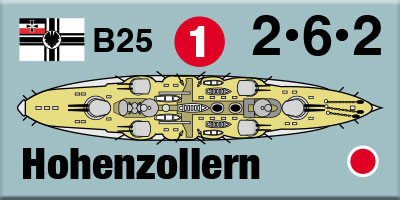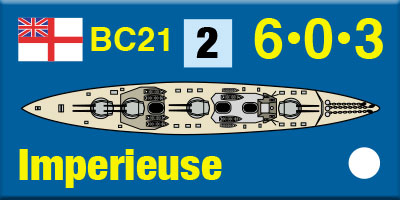| Risk Fleet:
Designer’s Ramblings
By Mike Bennighof, Ph.D.
September 2024
 There are a few wargamers (I doubt they’re more than a small minority) who are drawn to this stuff for the history. Sadly, a lot of the “history” in “historical games” is pretty weak: these things really aren’t that suited to serious historical inquiry. Except when they are. There are a few wargamers (I doubt they’re more than a small minority) who are drawn to this stuff for the history. Sadly, a lot of the “history” in “historical games” is pretty weak: these things really aren’t that suited to serious historical inquiry. Except when they are.
The opportunity doesn’t come often, but I think Great War at Sea: Risk Fleet does do a pretty good job of serving as a “thesis with counters.” Of course we had to leave out the boring parts. I did a fair amount of reading in some of the more recent scholarship the First World War, related to another project, and have been impressed by the Zuber Thesis. Put simply, Terence Zuber has put forth the proposition that there was no real “Schlieffen Plan,” at least not in the way its existence has been handed down as received wisdom for the past century.
Zuber can be a little strident in defense of his notion, and some of his argument boils down to what in grad school we learned to call a tautology (“it didn’t exist because it didn’t”). Even so, he does make a strong case for the so-called Schlieffen Plan to have been actually a plan for increased Army funding, not a plan for war. Alfred von Schlieffen, chief of the Great General Staff, counted on 24 divisions that did not exist to make his plan work. By insisting that this plan and only this plan could yield victory, the Army implicitly also insisted that the annual conscription class had to be increased (Imperial Germany took in about 55 percent of its eligible young men each year) and the budget boosted accordingly.

That resonated with me, as it dovetailed with an argument made by naval historians like Lawrence Sondhaus (who I should admit was on my dissertation committee). In short, Imperial Germany was not serious about challenging Britain’s Royal Navy at sea. Alfred von Tirpitz’s “Risk Fleet” could have been much larger if Germany had put her massive industrial and financial strength into the effort. In sort of a warped mirror image of the Army’s top bureaucrats, the Navy’s prime interest was victory in the annual budgetary fight with the Army. Pretty much the way it’s been in every democracy and a fair number of dictatorships for the past century or more.
Daily Content includes no AI-generated content or third-party ads. We work hard to keep it that way, and that’s a lot of work. You can help us keep things that way with your gift through this link right here.
That makes the essential question of Risk Fleet pretty easy to frame: what sort of fleet could the Germans have built had they been serious about challenging Britain? And the related questions: How would such a fleet have been used in battle? How would the British have reacted to a slots-out German building program?

The first question is the easiest to answer. In Risk Fleet, the Germans receive the ships requested for each fiscal year and turned down (in some cases, they were never formally requested, as the Navy understood they would not be approved and did not want to needlessly expend political capital).
The actual High Seas Fleet built five battleships in the 1904 fiscal year (the Deutschland class pre-dreadnoughts) but none in the 1905 and 1906 budgets (the 1906 budget did include the big armored cruiser Blücher). The naval arms race only took off with the 1907 fiscal year, with four dreadnoughts and one battle cruiser authorized. The 1908 year saw four dreadnoughts and no battle cruisers, and in 1909 the fleet was authorized two dreadnoughts and three battle cruisers. That slipped to three heavy ships in 1910 and four each in 1911 and 1912, dropping to two each in 1913 and 1914.

For Risk Fleet, the book, I gave the German Navy five heavy ships for each fiscal year from 1905 onwards. That yields five-ship classes of the 1904 semi-dreadnought design and the 1905 early dreadnought (which would have been authorized in the year following their design). Both were similar to the Nassau class built under the 1907 appropriation (in 1906 in our speedier timeline), but with 9.4-inch guns in the “wing” positions for the semi-dreadnought, and single mounts for 11-inch guns in those spots for the early dreadnought.
There’s a fifth member of the Nassau, Helgoland and König classes and a brand-new class of 1912 dreadnoughts (by the latter stages of the “dreadnought race,” the Germans were spreading authorization for each class over two fiscal years). The 1913 dreadnoughts, originally the Bayern-class super-dreadnoughts, are replaced by an alternative proposed design with a dozen 350mm guns in four triple turrets rather than eight 380mm guns in four twin mounts. For 1914, there’s the Bayern class of super-dreadnoughts as designed.

Just as with the dreadnoughts, the timeline of German battle cruiser construction is accelerated, with the Blücher class (now a class of six ships, with five new vessels included in High Seas Fleet) built in the 1905 program alongside the early dreadnought, and a pair of battle cruisers funded in 1906 with the Nassau class, to one fo the alternatives proposed for what became the lone battle cruiser von der Tann.
Von der Tann, Seydlitz and Derfflinger each get a sister ship, with a new class of two ships inserted and built to an alternative Seydlitz proposal (with all five turrets placed on the centerline). Another new pair of ships, to follow Derfflinger, adds a fifth main turret (a proposal rejected by Alfred von Tirpitz, to maintain a strict separation in the fighting power of battleships and battle cruisers and thereby keep their funding lines separate as well). There are also a few additional cruisers for the High Seas Fleet, though the dreadnought race was all about dreadnoughts (no one counted the lighter ships, but the Germans will need them to accompany all the new heavy metal).

The British reaction is sort of muted, since the Britain of our reality did panic over the supposed German building program and increased their spending and construction pretty close to their full capacity. The two Brazilian battleships that some urged the Royal Navy to purchase into service are represented, and a handful of additional dreadnoughts that were authorized or requested but denied for various reasons. And the British get to fulfill Sir John Jellicoe’s dream of a purchase or lease of the four Japanese Kongo-class battle cruisers.
And then there’s the third question, how these ships would be used. There’s no reason to think that the admirals of 1914 would be any more aggressive if they had more battleships to lose, but that doesn’t make for a fun game. The Germans in the new scenarios are much more active in challenging the British, now that they have the force to back up their boasting. And there’s a series of scenarios positing an earlier start to the war, mostly because I wanted to make use of that flotilla of Blüchers in a lead role.

I’m really pleased with this one, because it has a tight focus (both in its theme and in practical terms - it only draws on one game for other pieces and maps, Jutland) and studies a historical question using pieces and scenarios to play out said question’s implications. You don’t often get to use a wargame in that manner, and if you’re drawn to the history then I think you’re really going to like this one. If you just like big shiny objects, you get lots of new battleships. Everybody wins.
You can order Risk Fleet right here.
Beyond Jutland
Risk Fleet
Journal No. 38: Alternative Dreadnoughts
Retail Price: $54.98
Package Price: $45.00
Gold Club Price: $36.00
You can journey Beyond Jutland right here.
Sign up for our newsletter right here. Your info will never be sold or transferred; we'll just use it to update you on new games and new offers.
Mike Bennighof is president of Avalanche Press and holds a doctorate in history from Emory University. A Fulbright Scholar and NASA Journalist in Space finalist, he has published a great many books, games and articles on historical subjects; people are saying that some of them are actually good.
He lives in Birmingham, Alabama with his wife, three children, and his new puppy. His Iron Dog, Leopold, was a good dog.
Daily Content includes no AI-generated content or third-party ads. We work hard to keep it that way, and that’s a lot of work. You can help us keep things that way with your gift through this link right here.
|
